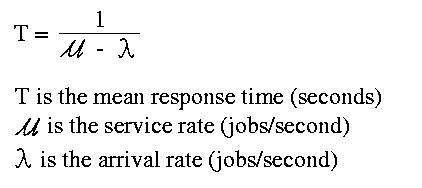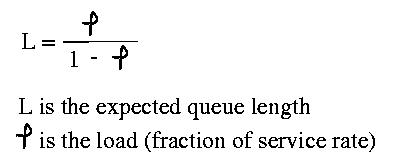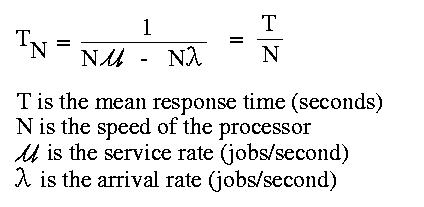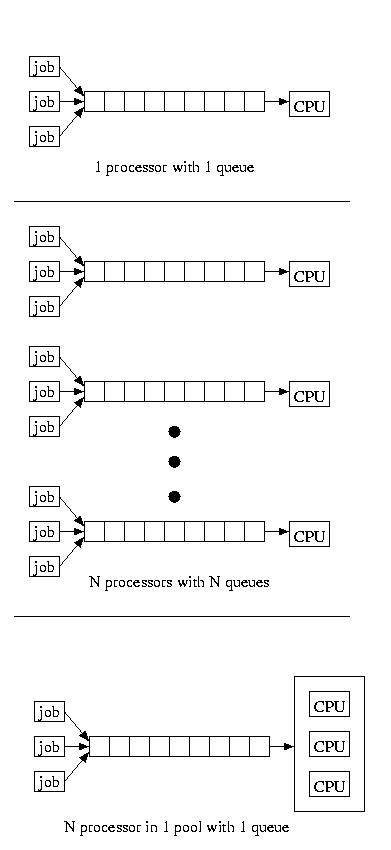Return to the lecture notes index
March 24, 2008 (Lecture 24)
Reading
- Chow and Johnson: N/A
- Coulouris, et al: N/A
Looking Ahead
Today, we are going to begin coverage of a traditional operating system
issue, but this time in a distributed environment: process allocation and
migration. We are going to ask the question, "Given many different
processors, which one do we use and when is appropriate to move to a
different one?"
But, before entering into that discussion, I would like to discuss some
preliminary concepts relavent to distributed scheduling. So, we'll begin
by looking at the economies of multiple processors, and then examine
threas, processes, and tasks in a distributed setting.
You Choose: One or N
Which is preferable, 1 processor, or N processors, each of which is
1/Nth as powerful?
In response to this question, most people point out the following
characteristics:
- Both options are equally "powerful"
- 1 processor is more likely to be completely functional than
N processors, each of which has the same likelihood of failing
as the single processor. If it is "all or nothing", this might
suggest that the single processor is more robust.
- The N processors are less likely to completely fail than the
single processor. In other words, if progress can be made with
only some of the processors, the N processors are "fail soft".
The surprising finding is this: The response time is better for a
system with one processor than N processors which are 1/Nth
as powerful. How can this be possible? Simple math shows:
N*(1/N) = 1.
Let's see if we can think our way through this situation. Let's begin
by defining response time to be the elapsed time between the
arrival of a job and the time that the last piece of the result is
produced by the processor(s). Now let's assume that there is only one
job in the system and that this job is indivisible and cannot be
parallelized. It is fair to assume that the job cannot be divided and
conquered, because any job can be reduced to a piece that is atomic.
This indivisible piece is what we will now consider.
Let's say that this job takes one unit of time in our one processor
system. If this is the case, it will take N units of time if
executed in the N processor system. The reason for this is that the
job can only make use of one processor, so it can only utilize
1/Nth of the power of the N procesor system.
Now if we assume that we have an endless stream of jobs, it might seem
like this problem goes away -- we can make use of all of the processors
concurrently. And, although this is true, it doesn't quite work out
so well in practice. As each job arrives, it must be placed on the
queue associated with one of the processors. Some queues may become
long and other queues may be empty. The backlog that builds up on
the queues that happen to be long is a penalty, whereas the unused
cycles on the available processors offer no reward.
If the arrival rate is less than the service time (which makes sense, if we
hope ever to complete all of the work), we can model the mean response
time for a system with a single processor and a single queue as below:

If you want to try to understand the formula above, you can think of
it this way. Take a look at the denominator of the equation. It
subtracts the arrival rate from the service rate. In other words, it
asks the question, "In each unit of time, if we execute all
of the jobs we have, how many jobs worth of time is left unused?"
If we have another job to submit, we must fit it into this unused time.
The question then becomes, "How many units of time does it
take for me to acquire enough left-over time to execute the new job?"
This subtraction yields the number of fractional jobs that are left
over per unit time, in this case seconds. By inverting this,
we end up with the number of units of time measured that are required
to execute the new job -- this includes the busy cycles that we spend
waiting, and those cycles used ofr the new job.
It might make sense to view this as a periodic system, where each
"unit of time" is a single period. The mean response time is the
mean case for many periods it wil take for use to find enough spare
cycles to complete our job. The piece of each period that already used
represents the cycles spent on th jobs ahead of us on the queue.
Given this, we can model the average queue length as below:

In other words, if the system is at 80% capacity,
L = (0.8/(1-0.8)) = (0.8/0.2) = 4
Again, a quick look at this can give us some intuition about why it is
true. If there are no spare cycles, the load average will be one and
the denominator will be 0, yielding an infinite expected queue length.
If the load average is 0, there are no jobs in the system, so the queue
is empty. If the load average is 80% or 0.8, we can only use 20% or 0.2
of each period for our job. This means that if our job requires 80%
of a period, we will have to wait 4 periods to acquire enough cycles,
hence an expected queue length of 4.
Given this, what happens if, instead of have one processor that has the
power of all N processors? Since it can handle N times as many jobs in the
same time, the service rate is N times greater. Since it is handling
the jobs that were previously spread out over N queues on the same queue,
the arrival rate is N times greater.
following:

Notice the surprising result: We get an N times speedup by having one
processor, instead of N processors that are each 1/Nth
as powerful!
If we service a pool of processors using a single queue, we find our
performance is somewhere in the middle. The service time is much like
having a single very powerful processor, with a single queue, except
the job take longer once it is dispatched, because the processor that
is executing it remains slower. For reference, the figure below shows
all three configurations:

It is a good thing for us that it is cheaper to by N slower processors
than a processor N times as fast -- otherwise distributed and parallel
systems would become less interesting (at least for the purpose of
improving the response time for computationally intensive tasks).
So, although distributed systems might not be useful for reducing the
response times for large, indivisible tasks, they can yield more
processing power for less money, greater availabilty, and greater
accessibility for distributed user communities.
Threads, Processes, and Tasks
When teaching operating systems, I introduce processes,
tasks, and threads, much as I will today. For those
of you who come to us from 15-213, this discussion will not be
entirely unfamiliar -- we painted the same picture with a larger
brush in 15-213.
In earlier times, computers were used to automate highly structured
processes. It wasn't the case that the word process
was arbitrarily selected as the name of the structure, within an
operating system, that represents a unit of user work. It was the case that
users had processes, in the conversational sense, that they wanted
computers to follow. These processes were processes whether represented
in high-level code or assembly code, or more human forms such as
flow charts for business processes or systems of equations for
mathematical processes.
Over time, the problems that people wanted to address by computer
became more complex. They could no longer easily be described using
a single flow of control. Instead, they were constructed by implementing
multiple concurrent, but interacting processes. Unfortunately though,
the old process structure implemented by operating systems was not
well-suited to this model.
Operating systems were designed to keep processes separate and invisible
to each other. Philosophically, this was, and remains, one of the goals
of operating systems: Allowing multiple processes to share the same
system, without knowing that they are sharing. And, perhaps more
importantly, keeping processes seaprate and hidden from each other
ensures that one process can not accidentally or maliciously damage
another. Unfortunately, climbing over the protective walls to allow
processes to communicate is, for reasons that we discussed in operating
systems, not cheap.
Eventually, a new abstraction was born, the thread, and abstraction
for a thread of control or one process within a task that
might contain one or more separate processes. Much like "process" means
much the smae thing in a human context as it does in the domain of
operating systems, the meaning of "task" is clear to even the uninitiated
observer. A task is nothing more than a unit of user work -- whether
it is a single process or multiple processes.
Modern operating systems implement protection around tasks, but allow the
threads within a task to share the same resources and enjoy the reduced
cost of interaction -- even if it means a greater risk of damage to one
thread by another.
For the curious, threads were originally born as an abstraction
for concurrency within the operating system kernel, and then
mimiced at the user level using libraries. Only relatively recently
have operating systems implemented the task abstraction and provided
kernel-level support for user-level tasks composed of multiple threads
of control.
Threads, Processes, Tasks -- And Distributed Systems
I'm going to tell a slightly different story in the context of
this class, Distributed Systems. For our purposes, let's
not worry about precisely defining threads and processes. Instead, let's
instead discuss tasks.
Today, I am going to tell you that a task is the environment
in which a thread executes. What do I mean by this? A task
is the collection of resources required to perform work on behalf of
a user. It consists of everything that is actually required by the
logic, all of the resources. For example, a task is composed of
open files, open network sockets, memory objects, and registers.
A thread is the logic behind the user's work and is influenced by
and manipulates the resources within the task. So, a task might contain
a single thread of control, or many threads of control. We'll call
tasks composed of a single thread of control processes.
Processor Allocation and Process Migration in Distributed Systems
Our discssion is going to involve picking a processor to run a process
and moving that process from one processor to another when appropriate.
Processor allocation involves deciding which processor should be assigned
to a newly created process, and as a consequence, which system should
initially host the process.
In our discussion of process migration, we will discuss the costs of
associated with moving a process, how to decide that a process should be
migrated, how to select a new host for a process, and how to make the
resources originally located at one host available at another host.
Although these algorithms will be discussed in the context of
processes, task with only one thread, they apply almost unaltered to
tasks containing multiple threads. The reason for this is that the
interaction of the multiple threads with each other and the environment
almost certainly implies that the entire task, including all of its
threads, should be migrated whole -- just like a single-thread process.
Unlike multiprocessor computers, it only very rarely makes sense to
dispatch different threads to different processors, or to migrate
some threads but not others. In distributed systems, the cost of sharing
resources on different hosts is usually far too high to allow for
this level of independence.



